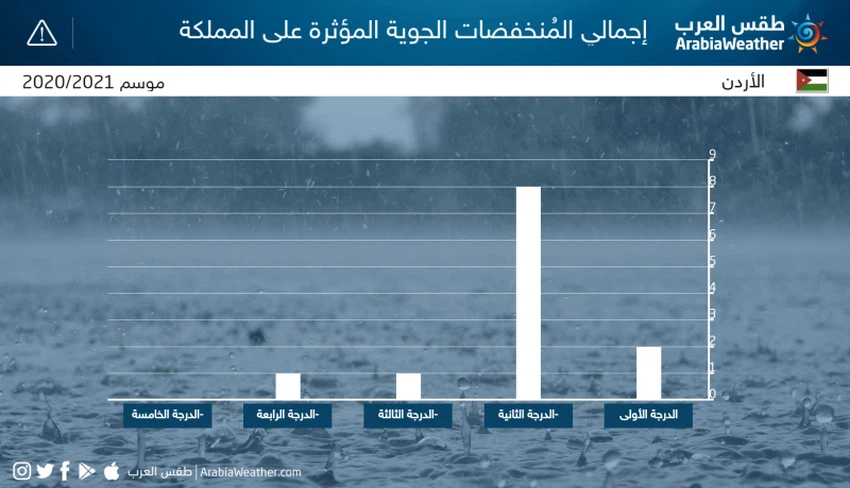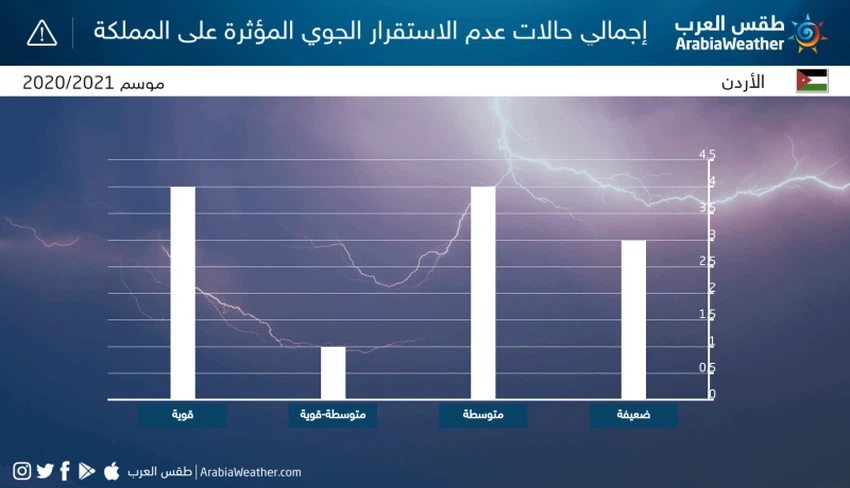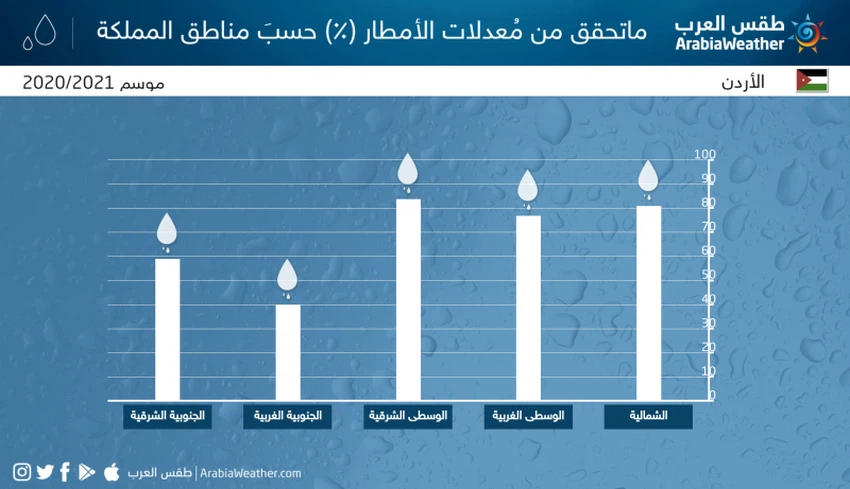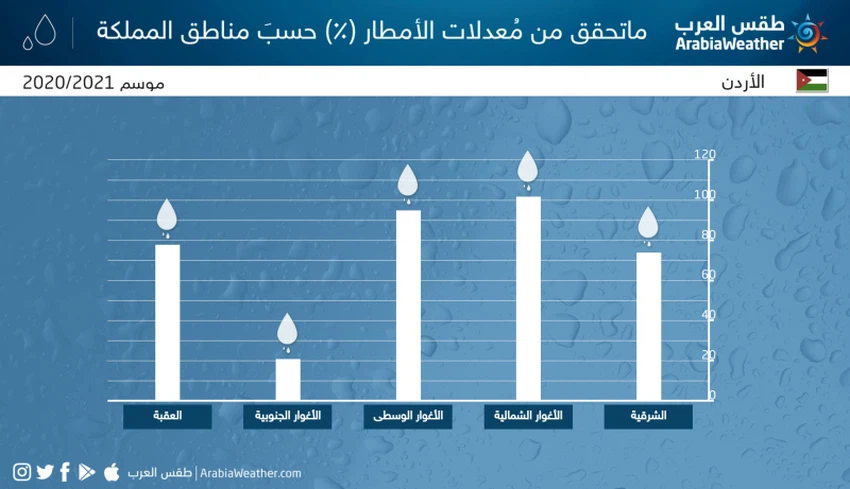Jordan | Archive of weather conditions that affected the Kingdom during the rainy season 2020/2021
Arab Weather - The weather forecast staff in the Arab Weather Company archives the most important data of the rainy season 2020/2021 for the purposes of future reference and comparison with winters and rainy seasons over the coming years, and the archive contains a general summary about the behavior of the rainy season, weather depressions, weather instability and others that affected On the Kingdom during the rainy season for a period extending from November 2020 to April 2021 as follows:
The total air depressions that affected the Kingdom during the rainy season 2020/2021 :

4-5/November 2020: Second-degree air depression ( normal ): The Kingdom was affected in the first week of November by the first air depression of this season, bringing with it cold winter weather and heavy rains in the north and center of the Kingdom, extending less sharply towards the northern parts of the south of the Kingdom The depression also caused excellent amounts of rain, the highest of which was in the west of the capital, Amman, where the amount of rain reached 65 mm, praise be to God.
November 15, 2020: Second-degree air depression ( normal ): The Kingdom was affected in mid-November by two air depressions for this season that brought with it a clear drop in temperatures and the prevalence of relatively cold weather during the day and cold at night, and heavy thunder rain fell in the north and center of the Kingdom, which extended towards some areas sparsely.
• 14-16/December 2020: Second-degree air depression ( normal ): The Kingdom was affected in that period by a second-degree air depression, as it crossed a cold air front on December 14, causing strong southwesterly winds and forming dust waves in the south and east of the Kingdom As rain fell from the north of the Kingdom to the city of Aqaba, and as a result of heavy thunderstorms, a partial collapse occurred along the coastal road in Aqaba, which led to the closure of the road in the two ports.
The weather also temporarily stabilized on December 15, in preparation for the crossing of a closed air front, which caused rainfall of varying intensity in many regions of the Kingdom. Mediterranean storm form (Medicine).
• 23-24/December 2020: First-degree air depression ( first ): The Kingdom was affected in that period by a first-degree air depression, which caused a drop in temperatures and showers of rain in some areas and the formation of thick and wide fog.
13-14/January/2021: Second-degree air depression ( normal ): On Wednesday and Thursday, the Kingdom was affected by a second-degree depression after rain had been interrupted for about 21 days, as a cold, unstable front crossed on Wednesday night, and the impact of the depression deepened on Thursday afternoon, as The temperature decreased and the southwest winds became active, and thunderstorms fell in the north, center and south of the Kingdom, including Aqaba, and the rain affected parts of the eastern regions.
16-18/January/2021: Second-degree air depression ( normal ): The Kingdom was affected on Saturday, January 16 by the introduction of a second-degree air depression, as rain fell in the north of the Kingdom, and the impact of the depression deepened on Sunday, January 17, as cold weather prevailed during the day It was very cold at night with rain in different regions of the north and center of the Kingdom, sometimes extending to some southern heights.
January 19-20/2021: A third-degree air depression ( medium-high ) accompanied by a very cold polar air mass : On Tuesday and Wednesday, January 19-20, the Kingdom was affected by the first third-degree air depression, and the first polar air mass, which caused a subsidence. Severe heat and very cold weather during the day with strong winds, as well as heavy rains and heavy and accumulated showers of hail in several regions of the Kingdom. The influence of the polar air mass also deepened after the departure of the air depression on Wednesday night, causing a large-scale wave of ice and freezing that spread across different regions of the Kingdom, followed by the control of the Siberian high and the rule of very cold weather with the blowing of eastern winds.
28-30/January/2021: A second-degree depression ( normal ): January ended with a second-degree depression, which was accompanied by the flow of polar winds, which caused a significant drop in temperatures and heavy rainfall in the north and center of the Kingdom. Those rains extended towards Parts of the southern regions, and rain was accompanied by thunder and hail, and snow fell over the high mountainous heights for limited hours in the north, center and south of the Kingdom. Those snows had accumulated to a limited extent in the upper Ajloun Governorate and the Rashadiya area in Tafileh.
16-18 February 2021: a Category 4 depression ( highly effective ) associated with a strong polar air mass. Cold : The Kingdom was affected by the first depression of the fourth degree of this season, which affected in two stages, as it crossed the first front on Tuesday evening, February 16, which led to a drop in temperatures, and heavy thunder rain in the north and center of the Kingdom, and snow fell over the mountainous heights whose height increases About 900 meters, and the most powerful main air front crossed the north of the Kingdom during the day on Wednesday, February 17, and extended on Wednesday evening to the center and south of the Kingdom, where heavy snow fell over areas that rise 800 meters above sea level, and extended below that in some periods.
The depression was also accompanied by strong winds accompanied by storm surges whose speed exceeded 100 km / h in some regions of the Kingdom, which caused the formation of dust waves in the desert areas, and the depression brought huge amounts of rain that reached and exceeded the limits of 100 mm in some northern and central regions of the Kingdom The largest thickness of snow in Ras Munif (Ajloun) was more than 60 cm of snow, and the thickness of snow in the west of the capital Amman reached 25 cm. Official institutions and bodies during the impact of the depression, and the snow that accompanied the depression is the strongest and most comprehensive since 2015, especially for the central and northern regions.
3-4 March/2021: First-degree air depression (the weakest ): The Kingdom was affected at the beginning of March by an air depression classified as first-degree, bringing cold weather and showers of rain falling on the north and center of the Kingdom, extending to some southern heights and were in the form of showers Light and unimpressive snow.
11-12 / March / 2021: Low Joy Class II (the ordinary course) affected by the Kingdom ahead of mid - month Trough air winter deep after it was low Khmascenia, bring deep low strong winds, which worked on the closure a number of desert roads in the Kingdom as a result The transported sand, the low and the lack of horizontal visibility, as heavy rain fell in many parts of the Kingdom, accompanied by the occurrence of strong thunderstorms.
March 26/2021: Second-degree ( normal ) air depression: At the end of March, the Kingdom was affected by a second-degree depression that brought cold weather and rain showers to the north and center of the Kingdom, but the depression was characterized by extreme cold, which was followed by dry polar winds that caused a wide formation The range of frost and low temperatures to approximately zero degrees Celsius in some areas at night.
The total cases of atmospheric instability that affected the entire rainy season 2020/2021:

1-2/November 2020: A ( strong ) case of atmospheric instability : The month of November began with a strong state of atmospheric instability that focused on the southern and eastern regions of the Kingdom and included the city of Aqaba in the first place. Heavy rainfall, hail and thunderstorms occurred in the south and east of the Kingdom, causing torrential rains to run in low-lying areas.
November 6-7, 2020: A ( weak ) case of atmospheric instability : After the first depression of the season, the Kingdom was affected by a weak state of atmospheric instability that caused some rain showers to fall in limited areas.
November 8, 2020: A ( medium ) case of atmospheric instability : On November 8, the Kingdom was affected by a moderately severe case of atmospheric instability that brought with it thunder rain towards some northern and central areas and caused heavy rainfall in the city of Sahab, east of the capital Amman, with the occurrence of lightning and thunder.
20-21/November 2020: A case ( medium to strong ) of air instability : The Kingdom was affected in the last third of November by a moderate/strong state of atmospheric instability that brought with it heavy rains towards the north, central and southern highlands of the Kingdom.
25-26/November 2020: A ( medium ) case of atmospheric instability : The Kingdom was affected by a complex weather condition that was in the form of unstable weather conditions classified as moderate in intensity, bringing with it a clear drop in temperatures and thunderstorms in many parts of the Kingdom.
November 29, 2020: a ( strong ) state of atmospheric instability : The Kingdom was affected by the last days of November with a strong state of atmospheric instability concentrated in the southern and eastern Badia, bringing with it thunder rain and hail, which led to the flow of torrents and a rise in the water level.
• 1-2/December 2020: a ( medium ) case of atmospheric instability : The eastern regions of the Kingdom were affected at the beginning of December by a moderate state of atmospheric instability that resulted in thunderstorms and hail falling with high intensity in some parts of the eastern Badia.
• 4-5/December 2020: a ( strong ) case of atmospheric instability : The Kingdom was affected during that period by a strong state of atmospheric instability, as heavy thunderstorms of rain fell in many areas, and torrential rains caused torrential rains in parts of the country. Irbid, the capital Amman, and Zarqa. The torrential waters stormed homes and shops, and torrents formed in the east of the Kingdom, causing the Baghdad International Road to be cut off in Safawi, and torrents raided a number of homes.
• 8-9/December 2020: a ( weak ) case of atmospheric instability : Parts of the Kingdom were affected in that period by a weak and limited state of atmospheric instability, which caused sporadic showers of rain, including including the capital Amman.
3-4/February/2021: A ( strong ) and comprehensive case of atmospheric instability : On Tuesday evening, February 3, the Kingdom was affected by the first strong and comprehensive case of instability in the season, which started from the south and southeast of the Kingdom in the form of thunderstorms that included the city of Aqaba, reaching The state of instability reached its climax on Wednesday, February 4, as thunder clouds pervaded all regions of the Kingdom, and rain fell that was thunder and heavy, accompanied by heavy showers of hail, and included precipitation, including the capital Amman. The state of atmospheric instability also worked on:
1- torrential rainwater torrents and waterfalls form in a number of regions of the Kingdom, especially the southern and eastern ones, and the water level has risen remarkably on the roads.
2- The interruption of Baghdad International Road towards Safawi and its closure due to torrential torrents.
3- The death of 4 people who were swept away by torrents in the east of the Kingdom, specifically the Al-Ruwaished area, "may God have mercy on them."
4- A number of people were besieged in different regions of the Kingdom due to the torrential rains.
22-25/February/2021: A ( medium ) case of atmospheric instability : Scattered areas of the Kingdom were affected by a moderate state of atmospheric instability concentrated in the south of the Kingdom, and caused showers of rain in narrow geographic ranges, and snow fell and accumulated (rarely). In such cases) over parts of the peaks of the Shara Mountains, which necessitated the opening of roads through mechanisms.
27-28/February/2021: A ( weak ) case of atmospheric instability : Parts of the southern and southeastern regions of the Kingdom were affected by a weak state of instability that caused scattered showers of rain.
Other weather conditions that affected the Kingdom during the rainy season 2020/2021:
26-31/December 2020: Extension ( Siberian High ) associated with a cold and dry air mass : In the last third of the month, the Kingdom was affected by the extension of the so-called Siberian Air High, which was accompanied by a cold and dry air mass, as very cold and dry southeast winds blew, which It caused a clear drop in temperatures, cold weather during the day and very cold at night, with frost formation on many nights in both the Shara Mountains and the southern and eastern Badiatin.
10/April/2021: An air mass ( polar ) and unusually cold for this time of the year was centered over Turkish lands : it pushed cold winds towards the Kingdom, causing cold weather during the day and very cold at night, and the temperature in the mountainous heights approached zero centigrade, as it was accompanied The polar air mass with the appearance of medium and high clouds and precipitation in the north and center of the Kingdom, with active westerly winds accompanied by strong gusts.
The percentage of achieved rainfall rates in the various regions of the Kingdom for the rainy season 2020/2021:

1- Northern regions: 81%
2- Western Central Regions: 77%
3- Central Eastern Regions: 84%
4- Southwestern regions: 40%
5- Southeast regions: 59%

6- Aqaba (King Hussein International Airport): 78%
7- Eastern regions: 74%
8- The Northern Jordan Valley: 102% (the highest percentage ).
9- Central Valleys: 95%
10- The Southern Jordan Valley: 21% (the lowest percentage ).
General information about the rainy season 2020/2021:
• Number of depressions by degree :
- First: 2
- Second: 8
Third: 1
Fourth: 1
Fifth: 0 (none)
Total ( 12 ).
• Number of cases of atmospheric instability by severity :
Weak: 3
Medium: 4
Medium to strong: 1
Strong: 4
Total ( 12 ).
• The most active month in weather events : February ( 2 ).
• The strongest air depressions that affected the Kingdom : an air depression of degree ( 4 ) on 16-18/February/2021 .
• The intensity of the rainy season : among the weak seasons during the last decade .
• The coldest and most active months of the season : February ( 2 ).
Note : The source of the percentage of the achieved rainy season rates is the Jordanian Meteorological Department, and the rest of the archived data are from the data of the Arab Weather Company.
Arabia Weather App
Download the app to receive weather notifications and more..



